Introduction
Clinical engineering is a new interdisciplinary field that integrates engineering and medicine, and CE is a relatively new profession among medical professionals. In this field, it is important to combine engineering disciplines and medicine to effective therapy.
Our goal is to foster clinical engineers with advanced expertise and a scientific research mind based on knowledge and technological skills.
Education
We teach courses in the field of clinical engineering, which involves the operation and control of medical devices such as hemodialysis, extracorporeal cardiopulmonary bypass, and ventilators. We also provide practical training in subjects related to clinical engineering technology. Before the clinical training at the hospital, we check if the students have mastered the basic clinical skills. The OSCE (Objective Structured Clinical Examination) conducted in clinical engineering education includes the confirmation of communication skills. The purpose of this is to ensure that the student is able to communicate with the medical team as well as the basic skills. This is a very important part of the program. We believe that one of the most important skills for students who want to become clinical engineers is the ability to work in cooperation with other medical staff.
Research
Various research projects which related clinical engineering performed in our labo, specifically, the effect of extracorporeal circulation on living body; the effect of redox state of body fluid components on somatic cells; construction of regenerative medicine using the interaction between polymeric materials and cells; the rapid diagnostic method using isothermal amplification for myocardial infraction (see below for detailed research theme).
Each student in the fourth year selects one of the research projects, acquiring skills for research and development and engaging in academic activities.
Members
Faculty members
Clinical engineering
-
 Makoto Hibiya
Makoto Hibiya
(Professor) -
 Masaru Ihira
Masaru Ihira
(Professor) -
 Atsushi Ohashi
Atsushi Ohashi
(Associate Professor)
-
 Kazunori Kawaguchi
Kazunori Kawaguchi
(Senior Assistant Professor) -
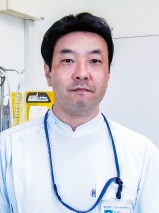 Hideo Hori
Hideo Hori
(Senior Assistant Professor) -
 Yasuko Enya
Yasuko Enya
(Assistant Professor)
Research Theme
Makoto Hibiya
1. Best Practices for Safe Extracorporeal Circulation The following studies are currently being conducted.
1) Research and study on standardization for safe extracorporeal circulation (2015-)
2) Evaluation of the current status of technology provision using extracorporeal circulation case registry data (2015-)
3) Research on objective evaluation of the effects of extracorporeal circulation(2015-)
Masaru Ihira / Yasuko Enya
1. Development of a rapid detection method for miRNAs by isothermal amplification.
2.The natural history of Human herpesvirus 6 (HHV-6)
3. The relationship rotavirus vaccine efficacy and the intestinal microbiome.
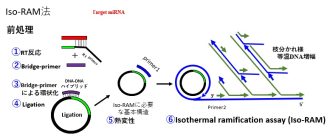 Principle of Iso-RAM
Principle of Iso-RAM
1. Development of a rapid detection method for miRNAs by isothermal amplification.
MicroRNAs (miRNAs) are from 20 -25 nucleotides of small non-coding RNAs that are involved in regulating a range of developmental and physiological processes; their dysregulation has been associated with the development of diseases. Therefore, the circulating miRNAs and exosomal miRNAs in blood have been proposed as being useful in diagnostics as biomarkers for diseases. However, However, there is no simple and rapid method to measure miRNAs. It requires expensive equipment, such as a real-time PCR machine or Next-generation sequencing. Our goal is to develop a simple and rapid diagnostic method for miRNAs using Rolling circle amplification (RCA) based on isothermal amplification technology.
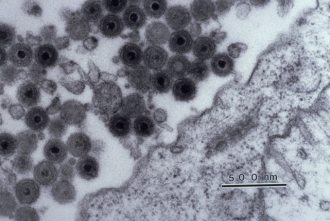 HHV-6 using an electron microscope.
HHV-6 using an electron microscope.
2. The natural history of Human herpesvirus 6(HHV-6)
Human herpesvirus 6 was isolated from peripheral blood mononuclear cells from AIDS in 1986. HHV-6 is divided into 2 viruses which are named human herpesvirus 6A and 6B. HHV-6B primary infection is the cause of the common childhood illness exanthema subitum. The HHV-6B reactivation is common in transplant recipients, which can cause several clinical manifestations such as encephalitis, bone marrow suppression, and pneumonitis. Recently, we focused on chromosomally integrated human herpesvirus 6 (ciHHV-6). The ciHHV-6 was explained as HHV-6 genome integrated to chromosome. The frequency of ciHHV-6 is 0.6% in Japan. Our lab investigates how ciHHV-6 occurs and the relationship of clinical manifestation.
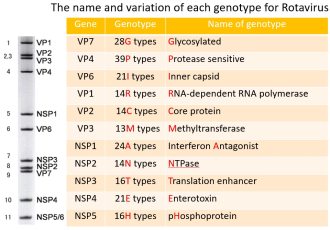
3. The relationship rotavirus vaccine efficacy and the intestinal microbiome
Rotavirus(RV) commonly causes severe, watery diarrhea and vomiting in infants and young children. Most children who get the vaccine will protect from RV severe disease. However, the vaccine efficacy against severe RV gastroenteritis ranging from 48-64% in developing countries is low compared to 85-98% in developed countries. There are several hypotheses as to Why oral RV vaccines are less effective in developing countries. One of the hypotheses is intestinal microbiome may be modulating an infant immune response to oral RV vaccine. Our lab investigates the relationship between RV viral load and the intestinal microbiome. Our DATA may be suggested that the suitable intestinal environment contributes to the immune response by RV vaccine strain amplification in the gut.
(Each research issue is collaborative research to Fujita health university pediatrics)
Atsushi Ohashi
1. Elucidation of the interaction between various blood purification devices and body fluid components
2. Development and evaluation of blood purification equipment
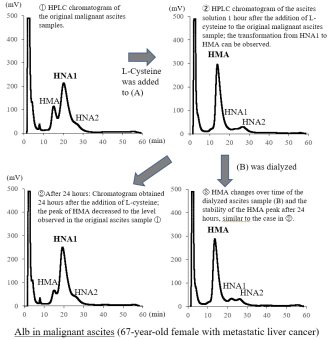
We analyze the pathophysiology of hemodialysis patients using laboratory analysis techniques. Specifically, we are studying oxidative stress caused by the biocompatibility of blood with medical materials and therapeutic devices.
Kazunori Kawaguchi
1.Novel therapeutic approach for Alzheimer's disease
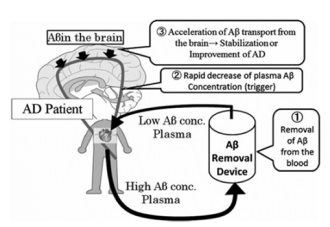
To investigate whether the removal of blood Aβ affect cognitive functions and Aβ burden in the brain, we studied 1) the cognitive states and plasma Aβ levels of renal failure patients with/without hemodialysis (HD), and 2) Aβ depositions of postmortem brains of hemodialysis patients for creation of Extra-corporeal Aβ Removal System (EARS) as a novel therapeutic method of Alzheimer’s Disease.
Hideo Hori
1. Creation of kidney regeneration device using interaction between polymer materials and cells
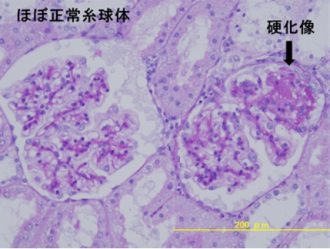
End-stage kidney disease occurs when chronic kidney disease reaches an advanced state. In end-stage renal disease, your kidney function is almost lost. End-stage kidney disease requires renal replacement therapy such as hemodialysis. In Japan, more than 340,000 patients undergo hemodialysis, and there are various issues such as quality of life and medical expenses. Therefore, we are developing a kidney regeneration device using polymer materials and cells to prevent end-stage renal disease. (Hideo Hori)
Photo Gallery
-
 The day of the national examination
The day of the national examination
-
 clinical practice
clinical practice
-
 Oath-taking ceremony for clinical practice
Oath-taking ceremony for clinical practice
Academic Activities
Manuscripts
2021
- Hasegawa M, Matsushita H, Yahata K, Sugawara A, Ishibashi Y, Kawahara R, Hamasaki Y, Kanno H, Yamada S, Nii N, Kato M, Ohashi A, Koide S, Hayashi H, Yuzawa Y, Tsuboi N. Evaluation of the performance, operability, and safety of Plasauto μ, a new type of machine for cell‐free and concentrated ascites reinfusion therapy, in a postmarketing clinical study. Therapeutic Apheresis and Dialysis 25(4):407-414, 2021
- Nobuya Kitaguchi , Kazunori Kawaguchi , Miwa Sakata , Hiroki Aoki , Kazunori Yamazaki , Megumi Kaneko , Jun Kinomura , Masao Kato , Midori Hasegawa , Nobuo Suzuki , Masao Mizuno , Yukio Yuzawa Aβ Influx into the Blood Evoked by Different Blood Aβ Removal Systems: A Potential Therapy for Alzheimer's Disease Neuropsychiatr Dis Treat. 2021 Jul 13;17:2291-2308.
- Kawamura Y, Higashimoto Y, Miura H, Ihira M, Inaba M, Ito R, Kozawa K, Yoshikawa T. Immune response against SARS-CoV-2 in pediatric patients including young infants J Med Virol. 2021 Mar;93(3):1776-1779.
- Miura H, Ohye T, Kozawa K, Hattori F, Kawamura Y, Ihira M, Kurahashi H, Yoshikawa T Coinfection With Human Herpesvirus (HHV)-6B in Immunocompetent, Healthy Individuals With Chromosomally Integrated HHV-6A J Pediatric Infect Dis Soc. 2021 Mar 26;10(2):175-178.
- Miura H, Kawamura Y, Ohye T, Hattori F, Kozawa K, Ihira M, Yatsuya H, Nishizawa H, Kurahashi H, Yoshikawa T. Inherited Chromosomally Integrated Human Herpesvirus 6 Is a Risk Factor for Spontaneous Abortion J Infect Dis. 2021 May 28;223(10):1717-1723.
2020
- Kanehira R, Ohashi A, Miwa N, Fujimoto H. Arm Model and Puncture Training System in Hemodialysis. Fuzzy Systems and Knowledge Discovery 962-969, 2020
- Yuta Saito , Miwa Sakata , Moe Kobayakawa , Hiroshi Kawachi , Kazunori Kawaguchi , Yoshiyuki Hiki , Masao Kato , Mayuko Mori , Midori Hasegawa , Norimi Ohashi , Yukio Yuzawa , Nobuya Kitaguchi Removal of Aβ Oligomers from the Blood: A Potential Therapeutic System for Alzheimer's Disease Neuropsychiatr Dis Treat. 2020 Mar 3;16:607-627.
- Ihira M, Kawamura Y, Miura H, Hattori F, Higashimoto Y, Sugata K, Ide T, Komoto S, Taniguchi K, Yoshikawa T. Molecular characterization of rotaviruses obtained from patients with rotavirus-associated encephalitis/encephalopathy Microbiol Immunol. 2020 4(8):541-555.
- Miura H, Kawamura Y, Hattori F, Tanaka M, Kudo K, Ihira M, Yatsuya H, Takahashi Y, Kojima S, Sakaguchi H, Yoshida N, Hama A, Yoshikawa T. Human herpesvirus-6B infection in pediatric allogenic hematopoietic stem cell transplant patients: Risk factors and encephalitis Transpl Infect Dis. 2020 22(1):e13203
- Kozawa K, Miura H, Kawamura Y, Tanaka M, Kudo K, Higashimoto Y, Ihira M, Yoshikawa T. Frequency of subclinical herpes zoster in pediatric hematology-oncology patients receiving chemotherapy: A retrospective cohort analysis J Med Virol. 2020 Aug;92(8):1260-1265.
2019
- Hideo Hori, Masanori Shinzato, Yoshiyuki Hiki, Shigeru Nakai, Gen Niimi, Shizuko Nagao, Nobuya Kitaguchi. Combination of nonwoven filters and mesenchymal stem cells reduced glomerulosclerotic lesions in rat chronic kidney disease models. International Journal of Clinical Medicine 10 135-149 2019
- Ohashi A, Nakai S, Yamada S, Kato M, Hasegawa MA Method for Stabilizing the Proportion of the Reduced Form of Albumin During Cell‐Free and Concentrated Ascites Reinfusion Therapy in Patients with Malignant Ascites. Therapeutic Apheresis and Dialysis 23(3):242-247, 2019
- Yamada S, Hasegawa M, Nii N, Kato K, Ohashi A, Suzuki R, Komatsu M, Abe K, Hata Y, Takahashi K, Hayashi H, Koide S, Tsuboi N, Inaguma D, Yuzawa Y. Comparison Between the Internal and External Pressure Filtration Method of Cell-Free and Concentrated Ascites Reinfusion Therapy Using the Same Cancerous Ascites. Therapeutic apheresis and dialysis, 23(3): 237-241, 2019
- Nobuya Kitaguchi , Harutsugu Tatebe , Kazuyoshi Sakai , Kazunori Kawaguchi , Shinji Matsunaga , Tomoko Kitajima , Hiroshi Tomizawa , Masao Kato , Satoshi Sugiyama , Nobuo Suzuki , Masao Mizuno , Hajime Takechi , Shigeru Nakai , Yoshiyuki Hiki , Hiroko Kushimoto , Midori Hasegawa , Yukio Yuzawa , Takahiko TokudaInflux of Tau and Amyloid-β Proteins into the Blood During Hemodaialysis as a Therapeutic Extracorporeal Blood Amyloid-β Removal System for Alzheimer’s Disease. Journal of Alzheimer’s Disease 69 (2019) 687–707
Conference
2021
- Ihira M., Suzuki N., Yasuko E., Higashimoto Y., Miura H., Kawamura Y., Yoshikawa. Dynamics of salivary Human Herpes virus-6 and-7 in pregnant woman. International herpesvirus workshop 2021(poster)
- Kawamura Y., Komoto s., Fukuda S., Kozawa K., Miura H., Enya Y., Ihira M., Taniguchi K., Yoshikawa T., Development of Herpes Simplex Vaccine type-2 Vaccine Has been Attempted Using Based on Rotavirus Reverse Genetics System. International herpesvirus workshop 2021(poster)
- Kozawa K., Hattori F., Kawamura Y., Miura H., Ihira M., Yoshikawa T. Analysis of clinical and pathogenic difference between apparent and inapparent infection of human herepesvirus-6 (HHV-6) International herpesvirus workshop 2021(poster)
2020
- 堀 秀生, 酒井 一由, 柴田 幸哉, 湊 大輝, 三枝 慎, 高畑 佳那, 大橋 篤, 中井 滋 脂肪由来間葉系幹細胞を用いたアドリアマイシン腎症ラットに対する細胞移植療法の検討 第19回日本再生医療学会(2020.5.18-29 オンライン発表)
- 井平 勝、塩谷泰子、東本祐紀、平松裕之、鈴木竜太、小澤 慶、三浦浩樹、服部文彦、河村吉紀、吉川哲史 妊娠期間中の唾液中Human herpesvirus 6,7排泄推移 第61回臨床ウイルス学会 口頭発表
- 塩谷泰子、井平 勝、平松裕之、鈴木竜太、東本祐紀、三浦浩樹、服部文彦、河村吉紀、河本聡志、谷口幸喜、吉川哲史 NICU入院時に対するRV1接種後の便中ロタウイルス株排泄と免疫誘導能の関連解析 第61回臨床ウイルス学会 口頭発表
- 服部文彦、三原由佳、河村吉紀、塩谷泰子、井平 勝、東本祐紀、河本聡志、谷口幸喜、吉川哲史 2018/2019シーズンに当院で経験したロタウイルス胃腸炎入院齢の検討第61回臨床ウイルス学会 口頭発表
- 加藤優紀子、平松裕之、鈴木竜太、河村吉紀、三浦浩樹、井平 勝、吉川哲史 ロタウイルスワクチン株吐き戻しによる便中ウイルス株排泄能への影響 第61回臨床ウイルス学会 口頭発表
Book
- 堀 秀生(分担執筆):第2章-1,2,5電気メス、マイクロ波手術装置、カテーテルアブレーション装置 臨床工学講座 医用治療機器学 第2版(篠原一彦編),pp.28-63,pp.88-89,医歯薬出版(2018年12月)
- 井平 勝(分担執筆):第2章-1心臓循環器計測、第3章1-4心拍出量計 臨床工学講座 生体計測装置学第15版(石原 謙編),pp.39-64,pp.130-142,医歯薬出版(2021年1月)
Access
- Access to Fujita Health University ⇒ Fujita Health University Homepage
- Access to Clinical engineering ⇒ FHU 7rd Building 6th floor

